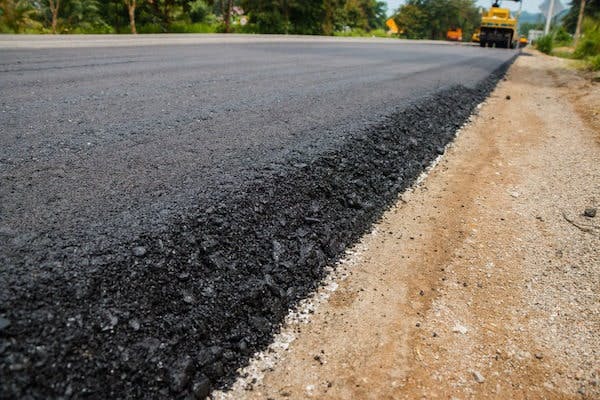Unlocking the Tricks of Warm Mix Asphalt Technology
Checking out the depths of hot mix asphalt innovation uncovers a globe where specific formulations and meticulous procedures assemble to form our roadways and infrastructure. The fusion of fillers, aggregates, and binders isn't simply a building and construction task but a tactical orchestration of durability and effectiveness.
Value of Warm Mix Asphalt
Warm Mix Asphalt plays a vital duty in modern-day facilities development because of its longevity and cost-effectiveness. As one of the most generally made use of paving product for roads, freeways, and auto parking great deals, Hot Mix Asphalt provides an array of advantages that contribute to its relevance in construction tasks. One vital advantage is its capacity to hold up against heavy web traffic lots and rough weather, giving a trusted and lasting surface for transportation networks. Additionally, Warm Mix Asphalt is economical in both preliminary building and construction and long-lasting upkeep, making it a favored selection for lots of framework tasks.
The durability of Hot Mix Asphalt stems from its structure, which includes accumulations, binder, and filler products that are carefully chosen and mixed to meet certain performance requirements. In general, the significance of Warm Mix Asphalt in infrastructure advancement can not be downplayed, as it proceeds to be a keystone of modern-day building techniques.
Elements of Asphalt Mixes
The structure of asphalt mixes includes carefully chosen aggregates, binder, and filler materials that are vital for achieving specific performance needs. Accumulations are the primary component of asphalt blends, supplying toughness and security. These accumulations can be all-natural, such as gravel or crushed rock, or synthetic, like recycled materials from old sidewalks. The binder, normally bitumen or asphalt concrete, holds the accumulations with each other and gives flexibility and toughness to the mix. The selection of the binder is crucial as it directly affects the mix's efficiency in various weather condition conditions. Fillers, such as hydrated lime or Rose city cement, are made use of to enhance the mix's workability and aging resistance. Angled Parking.
The combination and proportion of these components play a substantial function in establishing the top quality and efficiency of the asphalt mix. Designers very carefully create the mix to satisfy particular requirements, taking into consideration elements like website traffic quantity, climate problems, and sidewalk lifespan. Appropriate selection and harmonizing of aggregates, binder, and fillers are necessary for producing long lasting, long-lasting asphalt pavements.
Mixing and Manufacturing Strategies

As soon as the aggregates are selected, the binder, usually asphalt cement, is contributed to bind the products with each other. The binder's quality and quantity click here to read significantly affect the mix's adaptability, resistance, and stamina to ecological factors. In addition, fillers like hydrated lime or Rose city cement might be included to boost details attributes of the asphalt mix, such as its workability or moisture resistance.
During production, the aggregates and binder are heated, normally in between 250-325 ° F(121-163 ° C ), to assist in blending and guarantee appropriate finishing of the aggregates. The mixing procedure must be thorough to accomplish a homogeneous blend that promotes the desired performance characteristics of the asphalt. Different techniques, such as set mixing or drum mixing, are employed to achieve constant and high-grade asphalt mixes for construction tasks.
Elements Impacting Asphalt Efficiency
Variables influencing asphalt efficiency include a series of variables that influence the toughness, longevity, and overall top quality of asphalt pavements. One crucial factor is the high quality of materials used in the asphalt mix. The type and resource of aggregates, the binder high quality, and the additives all play a substantial function in determining the efficiency of the asphalt sidewalk. The rank of accumulations is important as it influences the mix's stability, resistance, and workability to rutting and splitting.

Environmental problems likewise influence asphalt performance. Temperature level variants, dampness infiltration, and web traffic loads can all influence the architectural integrity of the pavement. Layout considerations, such as sidewalk density and drainage, are crucial in making certain the long-lasting efficiency of the asphalt pavement. By carefully taking into consideration these elements, designers and specialists can optimize asphalt efficiency and enhance the solution life of sidewalks.
Sustainable Practices in Asphalt Technology

In addition, the resource development of warm-mix asphalt (WMA) technologies has actually gained traction in recent times. WMA permits the production and placement of asphalt mixes at reduced temperatures contrasted to standard hot-mix asphalt, leading to minimized energy intake and greenhouse gas exhausts. The use of porous asphalt blends can assist minimize stormwater overflow problems by enabling water to penetrate with the sidewalk and basics right into the ground, promoting natural water filtering and recharge procedures. By executing these sustainable techniques, the asphalt market can add to building a more resistant and eco pleasant facilities network.
Conclusion
In verdict, warm mix asphalt modern technology plays a vital role in contemporary facilities development due to its longevity and cost-effectiveness. By meticulously stabilizing components, employing proper blending strategies, and taking into consideration different aspects, engineers can create top quality asphalt blends that endure rush hour loads and rough climate condition. Embracing lasting methods, such as using recycled materials and warm-mix modern technologies, further improves the ecological friendliness of asphalt innovation.
Blending and production methods in warm mix asphalt innovation entail the specific mix and processing of accumulations, binder, and fillers to produce a high-performance and long lasting asphalt mix.Factors influencing asphalt efficiency encompass a variety of variables that affect the toughness, durability, and total high quality of asphalt pavements. Sustainable practices in asphalt technology include various campaigns intended at lowering the ecological impact of asphalt production and paving processes. By incorporating recovered asphalt sidewalk (RAP) and recycled asphalt roof shingles (RAS) into brand-new asphalt blends, the market can dramatically reduce the intake of raw materials and energy, while additionally lowering landfill waste.
WMA enables for the production and placement of asphalt blends at lower temperatures contrasted to traditional hot-mix asphalt, resulting in minimized power consumption and greenhouse gas emissions.